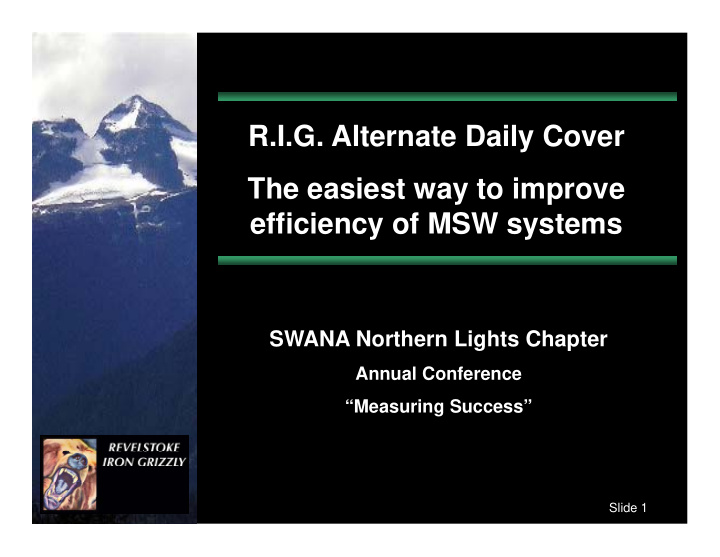



R.I.G. Alternate Daily Cover The easiest way to improve efficiency of MSW systems SWANA Northern Lights Chapter Annual Conference “Measuring Success” Slide 1
Best Practices • Build landfill progressively in Phases. • Build each phase using cells. • Each cell to be isolated with operational cover. • Two types of operational cover – Intermediate Cover (usually 300 mm) – Daily Cover (usually 150 mm) Slide 2
Daily Cover Why provide daily cover? • Isolate refuse from vectors. • Prevent fly-laying and emergence. • Reduce odours. • Control fire ignition / spread. • Minimize wind blown litter. • Cover hazardous substances. • Improve site aesthetics. Slide 3
Vector Control Regional gional Landf Landfill ill Nanaimo Nanaimo Gitlakdamix Landfill Nass Valley
Slide 5 Isolate Hazardous Waste
Exposed waste promotes emergence Slide 6 of flies
Without soil cover operators run huge Slide 7 risk of major landfill fire
If cover too sparse, waste pokes through
Too much cover means wasted air Slide 9 space
Just right operational cover usually translates to waste to cover ratio of 2:1 to 3:1
Daily Cover • Regulations require daily cover. – 150 mm soil at end of each day, or functional equivalent. • Options for cover include: – Local soil (clay, sand, gravel) – Contaminated soil – Dryland sort scrapings – Blended wood waste / soil – Alternate daily cover Slide 11
Cover Soil Type • Clay Soil – ruts – trafficability issues – leachate breakouts – dusty when dry • Sand – easy to work – trucks get stuck if dry • Gravel/Crush Rock – easy to work – free draining – great trafficability – expensive Slide 12
Typical Application of Daily Cover Slide 13
Alternate Daily Cover • Alternate daily cover provides same function (in some cases) as soil without consuming air space. • Options include: – tarps – spray on mulch – plastic films – wood waste soil blend – snow in winter – auto fluff (NO!!!) – shredded tires (NO!!!!) Slide 14
Slide 15 Wood waste soil blend
Slide 16 Tire Fluff ADC at Nova Scotia LF
Reusable Tarps are common ADC Solution
Enviro-Cover Enviro-Cover Con Cover (spray on) Con Cover (spray on) Tarp-O-Matic Posi-Shell
Economics of Alternate Cover Deployment of alternate cover takes about the • same time or slightly less than soil (10 to 20 min. per day). • Main savings are realized from air space saved by eliminating daily soil cover. Example from analysis of Nanaimo Regional • Landfill, operating at 44,000 tonnes/yr. – Soil Cover: $2,968/week – Plastic Film: $3,307/week – Tarp-O-Matic: $2,758/week Revenue gained from saved air space: $12,614 • per week, or $655,928/yr. Slide 19
Steel Plate ADC developed at Revelstoke Slide 20
R.I.G. Manufactured at BRESCO’s Slide 21 shop in Revelstoke, B.C.
Slide 22 Transported to site on trailer
Deployment with Loader
Typical cycle time is 90 seconds/plate Slide 24
Slide 25 7 R.I.G. Plates in Use Typical Active Face
R.I.G. can also be deployed with Slide 26 Excavator
Hydraulic Thumb improves control of Slide 27 plate
R.I.G. is not only ADC it is an engineered landfill construction system Slide 28
Slide 29 MSW is compacted against containment log
Well run landfill using R.I.G.
Advantages of Revelstoke Iron Grizzly ADC • Rigid plate does not flap in wind. • Snow can be scraped off plates without damage. • Plates will not rip or tear. • Birds cannot peck through plates. • No ongoing expenditures for new materials (film or mulch). • Plates cannot be removed by scavengers. • Plates can be placed with loader or excavator. • Plates are fire-proof. Slide 31
RIG CALCULATOR • Demonstrates economic benefits of ADC system • Input required for analysis: – Annual tonnage 30,000 TPY – Compaction Density 0.75 T/m3 – Landfill Tipping Fee $75/tonne – Lifespan 68 years – Footprint Area 40 Ha – Current Soil Cover Use 1.73:1 Slide 32
Example Calculation for Cranbrook Landfill 63.4 m 3 /day • Historic Soil Cover: 18.9 m 3 /day • Current Soil Cover: What is historic waste to cover ratio? 1.73:1 What is current waste to cover ratio? 5.81:1 What is annual air space saving? 16,245 m 3 What is annual Ops. Cost Saving? $85,930 What is value of air space saved? $527K What is annual cost saving (future revenue)? $35.76 million Slide 33
Summary • Daily Cover is 0.15 m soil or equivalent placed over active face at the end of each day • Alternate Daily Cover (ADC) should be considered to improve waste to cover ratio • R.I.G. Daily Cover (ADC) is most versatile and durable ADC system with minimal long term costs Slide 35
Contact Information Google: “ Revelstoke Iron Grizzly” www.irongrizzly.ca Brett Renaud (250) 837-8646 Tony Sperling (604) 986-7723 Slide 36
Recommend
More recommend